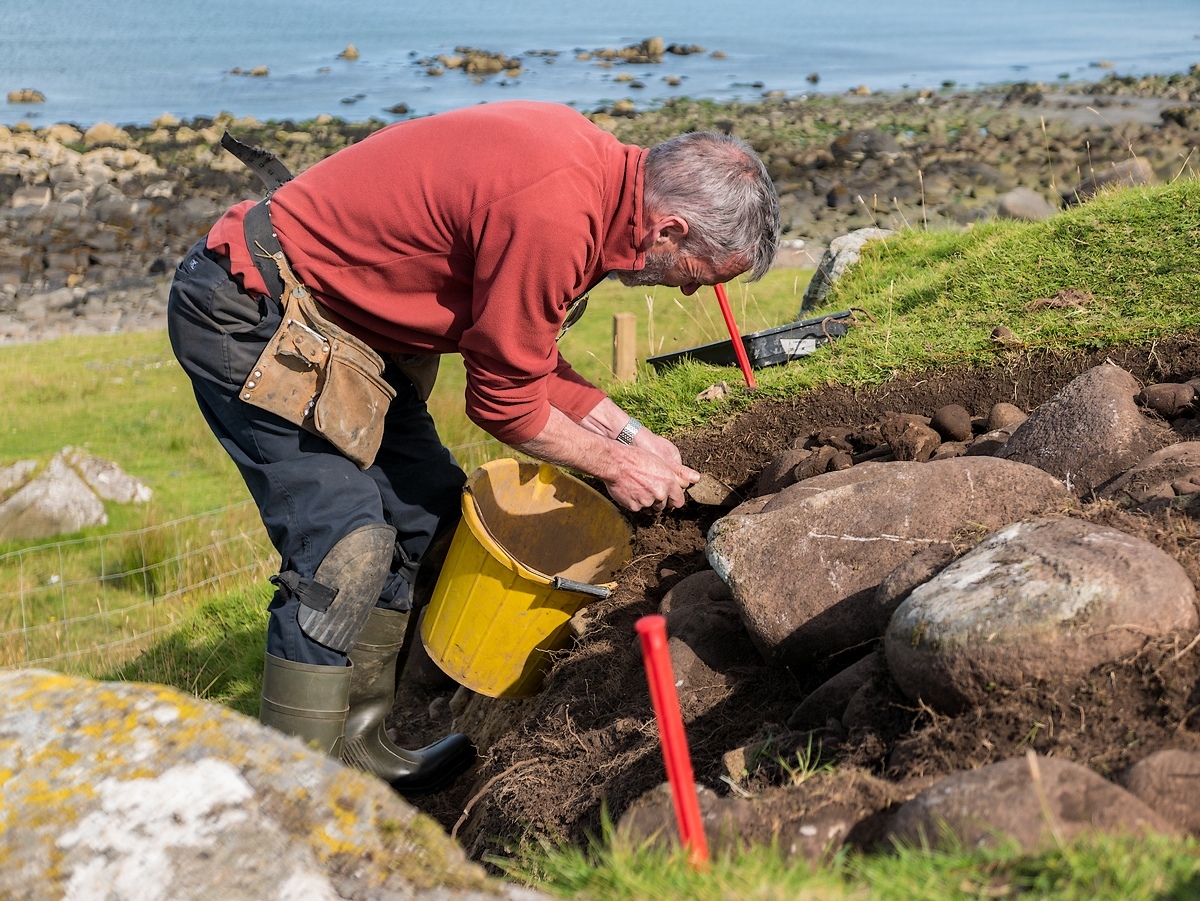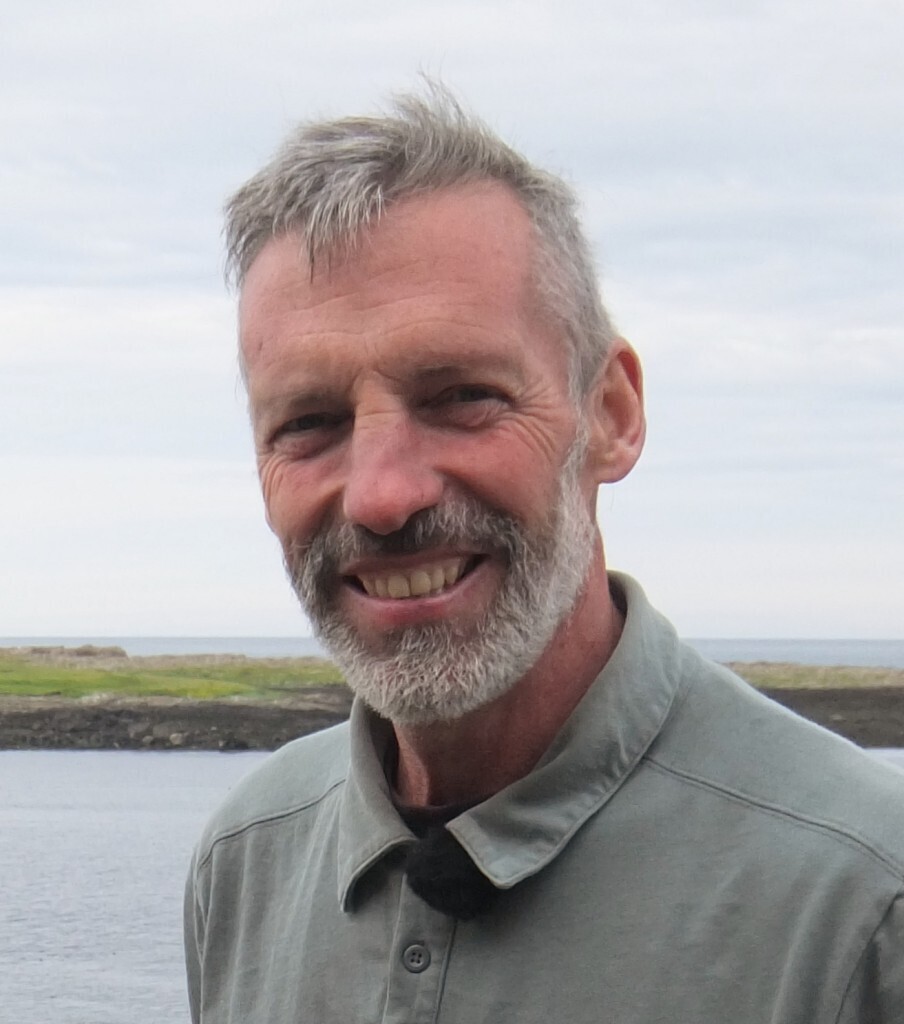Dr Dugald Ross of Eiliseadar (Dughall Cnoc an t-Sìthein), 1957 - 2025
Tuesday morning brought heartbreak to An Taobh Sear and far beyond our Skye shores when we heard that our beloved friend and colleague, Dugie Ross, had died.
Dugie served as a director of Staffin Community Trust over many years. We relied a great deal on the depth of his local and practical knowledge.
His interest in archaeology was sealed as a teenager when his father told him an intriguing story on the way home from peat-cutting in 1973.
Dugie noticed a circle of stones in the landscape. His father responded with the words, “Sin agad Clach an Airgid!” (Behold, The Money Stone!).
Intrigued, Dugie returned the following day when he unearthed six Neolithic arrowheads. The delight of this symbolic find fuelled his enthusiasm and was to navigate him through a lifetime of digging and unearthing in his locality. When he opened his first museum in Ellishadder, Dugie was still only nineteen years old.
Circumstances dictated that Dugie would stay at home to help with croft work. As a young man he made it his mission to learn everything he could about his landscape. Throughout his life, he never wavered from that mission.
For decades, he gave meaningful, memorable experiences to thousands of people who crossed his museum threshold. Every artefact brought forth a story that he unfolded like a treasured gift. Nobody told the stories of An Taobh Sear like Dugie. His memory was impeccable and his stories were full of colourful characters, tantalising diversions and humorous anecdotes. It was a delight to listen to his rich, distinctive Gaelic and to his clear, eloquent English.
Everything gleaned by Dugie was stored in his amazing mind. He catalogued his discoveries in a meticulous way, being very precise about where and when everything was found. And he knew where to put his hands on papers and articles.

There was never a more devoted reader of North Skye’s history than Dugie. And yet, he would argue that after many readings, he could still find new bits of information in William’s Mackenzie’s Iochdar-Trotternish and District.
Two days before Dugie passed, we had the official opening of our memorial to the Crofters’ Uprising at Creag an Fhèilidh (The Kilt Rock). One of the people involved in the Uprising in the 1880s was Ronald Maclean (Raghnall Cnoc an t-Sìthein) who is named on the Gaelic information panel now installed there. Dugie learned from his father that Raghnall Cnoc an t-Sìthein had found clay pots at Clach an Airgid and had been reimbursed for selling those to someone from Edinburgh.
After Ronald Maclean emigrated at the age of 60 to Saskatchewan in Canada, the Rosses crossed the moor from Mariseadair and assumed the tenancy of Ronald’s croft. It was from that time (about 1913) that Dugie’s family became known as Rosaich Cnoc an t-Sìthein. The family were renowned as great craftsmen. Bha sin anns na daoine. And that was our Dugie. He could turn his hand to anything - be it wood, stone, metal or horn. He did all aspects of croft work and was said to be particularly skilled at lambing and calving.
If you listen to the numerous recordings of Dugie online, it is clear that he himself has done all of those jobs with his own hands. Not many people realise that Dugie was also an artist. His works – in paint and wood – grace his family home.
In the early 1990s, Dugie built the current museum from what was previously a school. It is famous today for having the most important national collection of Scottish dinosaur remains, which date from the Mid-Jurassic period. When he was awarded The Mary Anning prize for Palaeontology in 2016, Dr Brusatte of the University of Edinburgh said:
“Dugie Ross is one of the most remarkable people I’ve ever worked with. He has almost single handedly uncovered the prehistoric history of Skye by finding the bones and footprints of dinosaurs that lived there 170 million years ago, making sure these are conserved, working with scientists to study them, and then displaying them publicly in a museum he built with his own two hands.”
An honorary doctorate in Palaeontology from the University of Edinburgh followed in 2024.
Almost every item in his museum has been gathered by his hands and has local resonance. The human artefacts span five thousand years – from the Neolithic era to the diatomite industry which came to a close here in 1960. Dugie was particularly fond of the anvil in the museum which - being very pitted, he believed had originated in the Iron Age fort of Dùn Grianan on Loch Mealt. The spinning wheel belonged to Mòrag Nicolson from Màlaigear and was gifted by her son, Murdaidh, who being a bodach in 1973, hired Dugie to shear his sheep. Is ann “fo spiris nan cearc” a lorg Dughall a’ chuibhle-shnìomh. Dugie discovered the spinning wheel under the hens’ roost.
Henry Castle, artist of Sùil nam Brà, discovered on a field trip with Dugie a bronze annular brooch. Such adornments were common in the 18th century. Henry later said that the memory of scouring the coastal caves with Dugie would remain with him always. He acknowledged the huge contribution of Dugie to Sùil nam Brà, and was humbled that the brooch which he discovered is today an artefact in Staffin Museum.
Every encounter with Dugie was a joy. Every placename had a fascinating story attached. This was due not least to his prodigious memory. A trait that the Gaels were once famous for, Dugie had it in spadefuls.
When we were creating the Skye Ecomuseum almost twenty years ago, it was Dugie whose knowledge we relied upon absolutely. He never lost patience with people, but was always gracious. He was a wonderful educator for Gaelic-medium visits for students of Sabhal Mòr Ostaig and Comunn na Gàidhlig events. Schoolchildren had scores of field trips with Dugie, to explore the landscape. For eight years, Dugie was involved with Roddy Maclean’s Gaelic course, ‘Àrainneachd, Cànan is Dualchas’. Over long decades he gave his time freely to unversity students from all over the world.
During the week-long community excavation at Lag na Sailean in 2015, Dugie was truly in his element and a real driving force alongside Dan Lee of the UHI’s Archaeological Institute. More than two hundred people of all ages attended The Dig, entitled ‘Fo Fòid na Tìme’. Dugie was equally at home teaching the schoolchildren, as he was with the intrigued older members of the community. Dugie was self-taught but the respect shown by the archaeologists on site shone through from Day One.

“It was so enjoyable working with Dugie on the project, Fo Fòid na Tìme,” Dan said earlier this week. “He had expansive knowledge, and such drive and passion, through his personal discoveries, the Ecomuseum, dinosaur fossils and the museum.”
Dugie was active across all of Staffin Community Trust’s work and freely gave up his time to support his own people. Long before Taighean a’ Chaiseil became a reality by providing affordable homes to local families, Dugie was busy carrying out test probes of the peat levels on site and freely offered his contractor’s knowledge and wise counsel whenever it was required. It was the same for the Staffin Harbour development and the construction of the viewing platform at Lealt.
He was a modest, unassuming man with no shortage of ability who simply got on with doing exactly what was needed without any fuss.
Dugie read our landscape like no other. He understood his landscape like no other. And nobody loved this landscape as Dugie did. It’s what we call in Gaelic dùthchas – the coupling of people and place over generations and throughout time. Not only did he read the landscape on multiple levels, but he read people and saw what others didn’t. He treasured people whom society had overlooked.

Apart from all of his talents and attributes, Dugie was the loveliest company. He had abundant goodwill and made time for everybody. We are so proud of Dugie, not least for his life’s work and legacy but much more importantly that someone so kind and gentle and remarkable was a man we could call a true friend.
A mere fortnight before he passed, Dugie and Debbie experienced the joy of becoming grandparents when Fionnlagh beag was born to Cameron and Emma in Vancouver. We send our heartfelt condolences to Dugie’s family, including daughters Caroline and Catrìona and their partners, James and Jamie, whom he loved with all his heart.
Though it is very hard to lose him, we walk tall in the knowledge that Dugie was our great enlightened friend of whom we are immensely proud.
Mar sin leat, a Dhughaill chòir. Turas sàbhailte dhut, a charaid. Bidh cuimhne againn ort aig Rubha nam Bràithrean. Aig Dùn Rèiseaborg. Aig Sgùrr a’ Mhadaidh Ruaidh. Aig Tobhta Ruairidh Dhòmhnaill a’ Chùirn. Aig Lag na Sailean. Aig Linne a’ Phost. Agus aig Àirigh Nic Cuithein. Chan eil am mìorbhail ach ann an gràdh.
There is no miracle but in love. Dugie taught us much, but that is the crux of what Dugie really gave to us all.